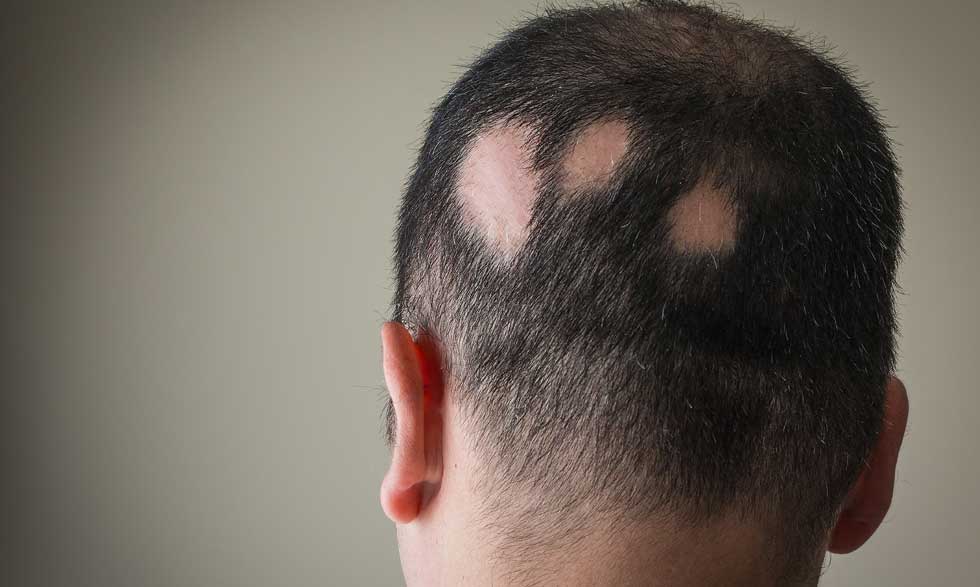Resolve your Alopecia Areata condition with the help of Hairrich Hair Restore Center, the best treatment for alopecia areata in Kurnool.
Alopecia areata more often called as patchy hair loss. Alopecia areata is a common, chronic, non-scarring alopecia that occurs in small patches, which can be unnoticed. It develops when the immune system attacks the hair follicles, resulting in hair loss.
The severity ranges from small patches of hair loss, which usually recover spontaneously, to total involving the scalp or complete body hair loss called Alopecia Totalis or Universalis. Usually, it affects the scalp, and in some cases, the face involving eyebrows or eyelashes, as well as other parts of the body can be affected.
Alopecia areata is associated with several autoimmune diseases such as thyroiditis, lupus erythematosus, vitiligo, and atopic dermatitis; and are associated with early-onset and more severe forms of alopecia areata. However, it most often noticed that in individuals who have a family history of autoimmune disorder, such as type 1 diabetes or rheumatoid arthritis; suggesting a genetic contribution to the development of alopecia areata.
Alopecia areata is an autoimmune disorder, which means your immune system becomes over active and attacks the body’s own cells. The immune cells which are supposed to protect our body from any foreign body damage our own cells. The hair follicle in the affected area is attacked by immune cells, causing disruption of hair follicles which leads to weakening of the hair roots and stop producing hair, leading to hair loss. The exact cause of origin is not revealed, but certainly possible triggers such as infection, medications, environmental factors, and extreme abrupt stress could induce an overactive reaction from the body’s immune system.
The usual symptom of alopecia areata is hair loss. Hair loss occurs in small round patches over the scalp. These patches commonly are not in higher centimeters. Hair fall may occur over face involving beard, mustache, eyebrows, and even other parts of the body.
You may initially notice a cluster of hair on the pillow or in the shower, and in some instances, patches over the back of the head noticed by others.
Though the hair loss caused by other condition also has a similar presentation, need to be differentiated. Moreover, in a few individuals, the hair loss can be too extensive; this can be a sign of alopecia areata or Universalis.
Types of Alopecia Areata depend upon their symptoms, extent of hair loss, prognosis, and also varying treatment.
This is a classical and usual type of alopecia areata with is one or more coin-sized patchy hair loss, often involving the scalp and or face. It can progress to the surrounding area to become Alopecia Totalis or Alopecia Universalis .
The presentation is similar to male or female pattern baldness, where there sudden diffuse thinning of hair over the entire scalp; unlike classical patchy hair loss of alopecia areata.
Ophiasis is a form of alopecia areata, distinguish by snake-shape like hair loss involving the circumference of the head or at the margins of sides and lower back.
Alopecia Totalis: hair loss involving the entire scalp.
Alopecia Universalis: Hair loss involving the entire body. Here the hair loss involves the scalp, as well as facial hair including eyebrows and eyelashes; with the possibility of involving body hair such as the chest, back, extremities, pubic area.
The course or prognosis of hair loss in alopecia areata is uncertain; the hair can grow back spontaneously some time and may fall out again. The extent of hair loss and regrowth varies from each individual.
At present, there is no universal treatment guideline available for every patient of alopecia areata, as some treatments are effective for some patients. The treatment depends on the type of alopecia areata, age, and extent of hair loss. As there are different treatment options available. The main goal of treatment is to chunk the immune system attack and to stimulate the re-growth of hair.
Oral immunosuppressive drugs such as cortisone tablets are sometimes used for extensive alopecia.
Oral immunomodulators, like methotrexate, azathioprine, and cyclosporine, are another option and work by blocking the immune system.
These drugs used for a long period of time have the risk of side effects, such as high blood pressure, liver or kidney damage, and other serious effects.
Targeted phototherapy or 308 Excimer are opted for localized or limited alopecia areata and recalcitrant to treatment.
Conventional Whole-body Narrowband UVB or PUVA-psoralen+UVA called photochemotherapy for hair loss involving extensive areas of the body such as Alopecia Universalis or Alopecia Totalis with other parts of the body
Interventional treatment such as mesotherapy, derma roller, low-level lasers , or platelet-rich plasma along with medical treatment; work as supportive therapy for alopecia areata. These treatments are useful in hair loss resistant to medical treatment.
However, alopecia areata does not cause any physical pain, but it causes emotional or psychological pain, especially when it affects the whole scalp and or if it involves the face like eyebrows. The patient feels more isolated or become depressed. To combat this situation counseling and change in lifestyle play an important role.

